The door to interconnectivity among chains is about to open. This article will provide you with a detailed introduction to the core concepts, technical features, and progress of Initia.
Written by: Shenchao TechFlow
"One-Click Chain Launch"
The reduction in the cost of launching chains has led to an increasing number of Layer1 and Layer2 projects in the market. Regardless of whether you believe a new chain is useful, it is undeniable that there will be more projects launching their own chains due to specific demands.
Just as there are more and more DEXs, there will be projects creating a "DeFi liquidity layer";
But when there are more chains, what ways can connect all these chains together?
Today's protagonist, Initia, is addressing this issue.
Last week, Initia announced the completion of a $14 million Series A funding round and a $2.5 million community funding round, bringing the total funding to $25 million. This includes a $7.5 million seed round funding participated by Binance Labs, Delphi Ventures, HackVC, and others last October. The official announcement also revealed that the mainnet launch and TGE will be completed in Q4.
Yi He, co-founder of Binance and head of Binance Labs, commented: "Binance Labs continuously identifies infrastructure providers that introduce novel solutions to accelerate the growth of Web3 applications. Initia's innovative architecture and tools are an important step towards widespread adoption by a new wave of developers."
A year has passed, and in this issue, we will provide you with a detailed introduction to Initia's core concepts, technical features, and progress, as the door to interconnectivity among chains is about to open.
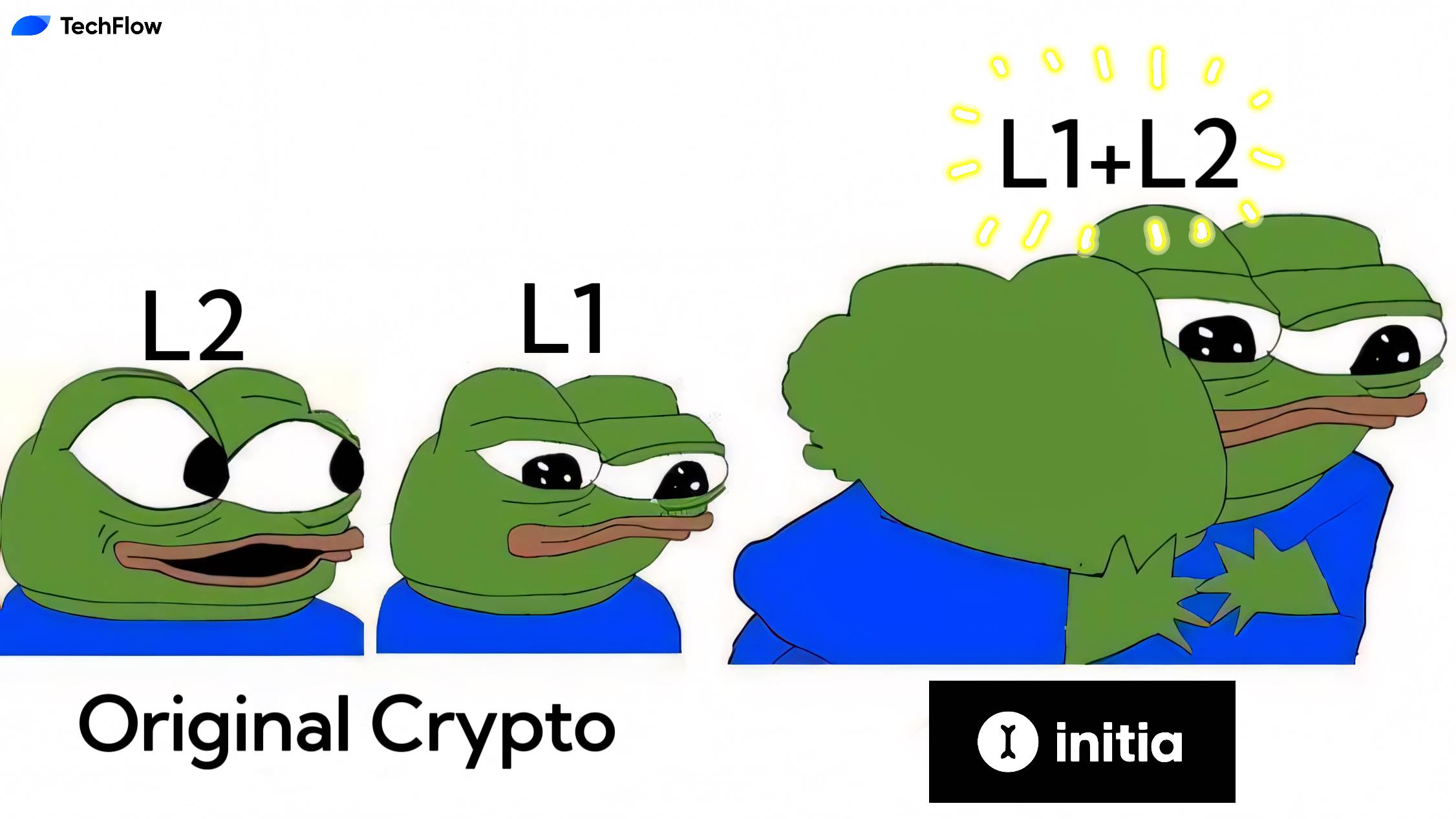
Building a Technical Stack from 0-1 to Create an Interwoven World of "Interconnectivity Among Chains" 🪢
When you start to understand Initia, you will see the word "interwoven" frequently, which translates to interwoven.
Here, the meaning of interwoven refers to the ability for different Layer2s to achieve interoperability, which will be reflected in consistent user experience, shared liquidity, and security, among other aspects. Additionally, since Initia supports EVM, MoveVM, and WASM, theoretically, both Ethereum and non-Ethereum projects can smoothly migrate to Initia for interoperability.

Of course, this does not currently include SVM. Initia co-founder Zon mentioned in a previous podcast that they would consider supporting SVM in the future if demand increases.
Is Initia Layer1 or Layer2?
Initia = Layer1 + Layer2. To realize Initia's vision, Initia has actually built an entire new technical stack from 0-1, developing both Layer 1 and Layer 2.
According to the official statement: Having a complete technical stack will enable Initia to implement chain-level mechanisms to coordinate the economic interests of users, developers, Layer 2 application chains, and the Layer 1 chain itself.
For more details, refer to the project documentation: https://docs.initia.xyz/
Introduction to Basic Concepts of Initia
Before we delve into the mechanisms and implementation logic of Initia, it is necessary to clarify some new concepts and terms, which will help us better understand Initia's long-term vision.
- Ominitia / Initia / Minitia / OPInit Stack
Initia: Full name Initia Orchestration Layer, i.e., Layer1, abbreviated as Initia. This is the foundational layer that coordinates network security, consensus, governance, interoperability, liquidity, and inter-chain messaging.
Minitia: Initia Rollups, i.e., Layer2, also known as "Minitia" or mini Initias. These are Layer2 solutions built on top of Initia Layer1, designed to enhance scalability and transaction throughput. They can run on EVM, MoveVM, or WasmVM, with the underlying technology being CosmosSDK.
OPInit Stack: This refers to the Initia Optimistic Rollup framework, abbreviated as OPInit Stack. OPInit Stack is the Optimistic Rollup framework built by Initia in CosmosSDK, designed to protect Initia Rollups through fraud proofs and rollbacks.
Ominitia: A platform that includes all core components such as Initia (Layer1), Minitia (Layer2s), OPInit Stack, Bridging Middleware, etc., referred to as Ominitia.
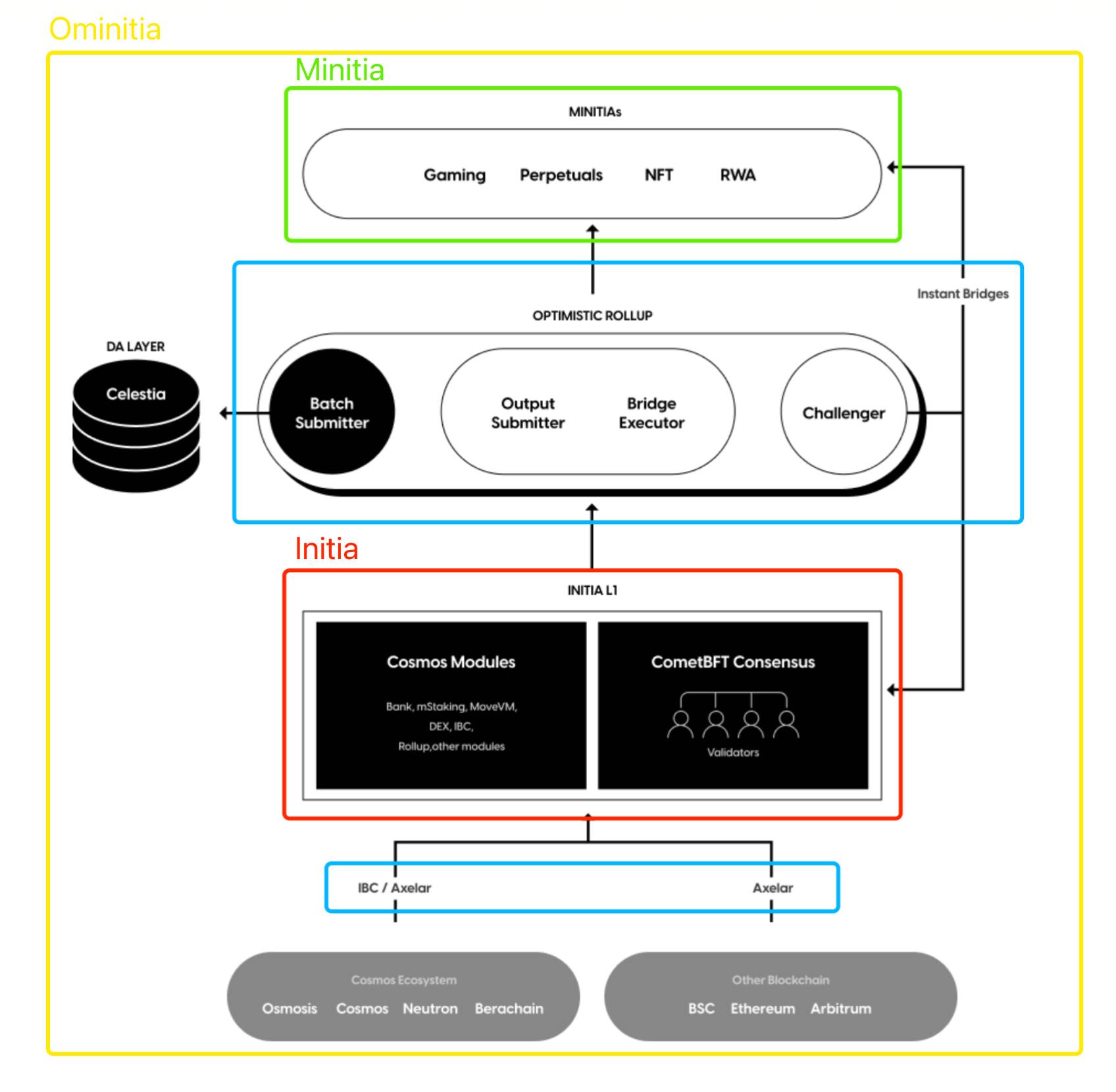
- Enshrined Liquidity / InitiaDEX / VIP
Enshrined Liquidity: Initia Layer1 introduces a unique consensus method, utilizing a Delegated Proof of Stake (DPoS) mechanism, enhanced through the x/mstaking module. This module allows multiple tokens to be staked directly to validators for voting rights. The module accepts separate INIT tokens from InitiaDEX or whitelisted INIT-X (corresponding Token) LP tokens as stakes, a mechanism known as Enshrined Liquidity.
This approach increases liquidity on L1, facilitates interaction between L1 & L2, enhances LP staker rewards, reduces security dependence on the volatility of a single $INIT token, and offers various other benefits.
InitiaDEX: InitiaDEX is the cornerstone of the Initia blockchain, built using the Move language on Layer1. InitiaDEX is not just a trading platform; it is also an indispensable part of the Omnitia ecosystem, aimed at facilitating liquidity and ensuring seamless interaction between Layer1 and Layer2.

VIP: Full name Vested Interest Program. Initia believes that as Rollups increase, there often arise issues such as inconsistent incentive mechanisms for dApps, underutilization of native tokens, and inefficient distribution of incentives/subsidies at the protocol layer. Therefore, Initia aims to address the profit distribution issues of Minitia (Layer2s) through the VIP program, coordinating the interests of various participants in the protocol and promoting healthy ecosystem development. More details will be introduced later.
The above is an introduction to some important concepts. In summary, Initia has designed multiple unique mechanisms to coordinate the ecosystem towards a unified direction and encourage truly valuable innovations. For more information, please refer to the official documentation.
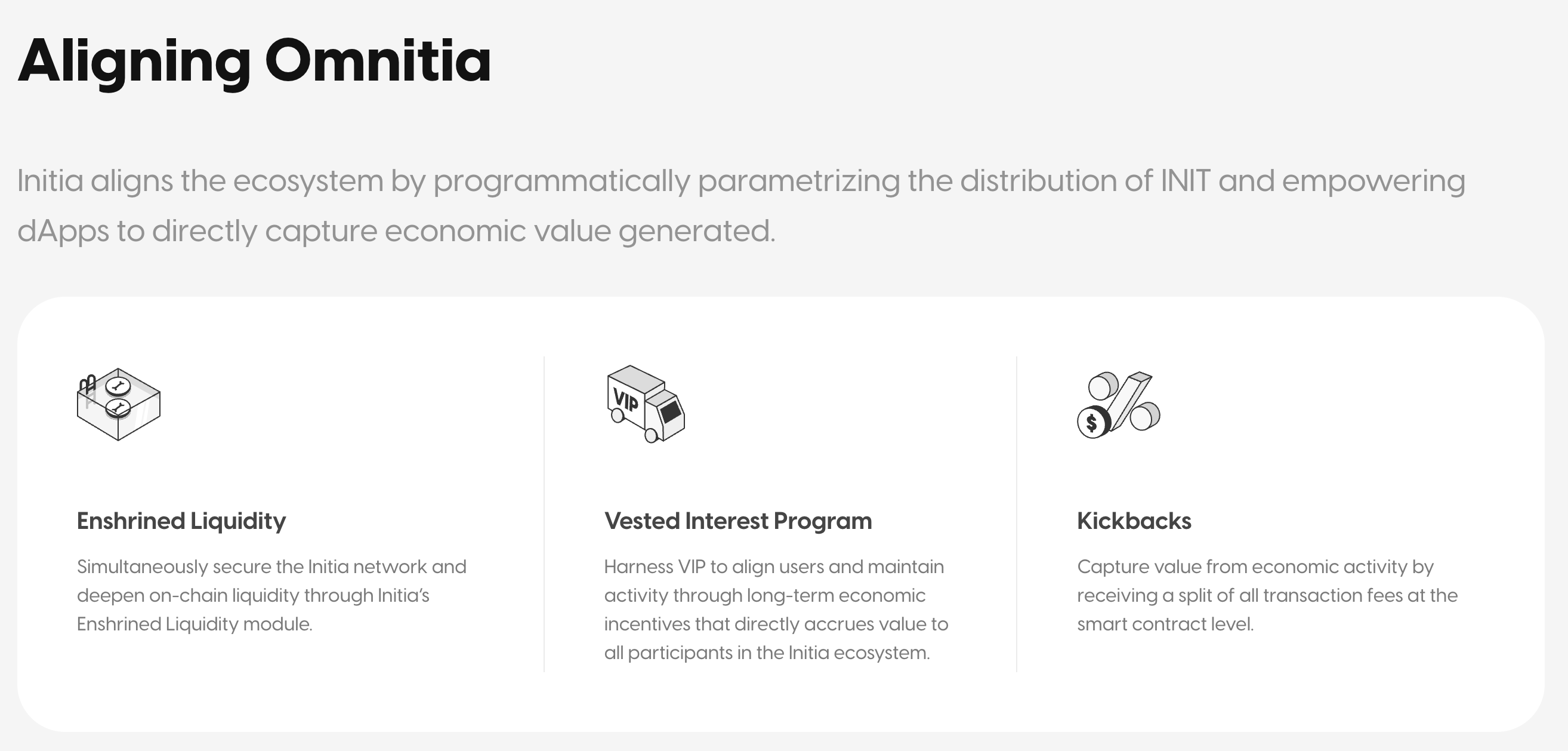
Apple vs. Android: Providing the Best User and Developer Experience
For any public chain, users and developers are essential components of its ecosystem. Many public chains attract developers or users through rewards, hackathons, etc. For Initia, the goal is to provide the best interaction experience (BEST UX/DX) for both developers and users.
Seamless Interaction Experience for Users
In a previous sharing, Initia co-founder Stan explained Initia's design philosophy, emphasizing that Initia's initial concept considers the liquidity of users across different applications. While many heavy Ethereum users can easily move assets on the main chain, the situation becomes complicated when using Layer 2.
Especially for users who are not very familiar with the ecosystem, when they want to cross-chain from one Layer2 to another, they may need to consult DefiLlama just to know how to operate, and when users are actually performing operations, they may face various token standard confusion issues.
Therefore, Initia decided to build a new ecosystem to simplify cross-chain operations and enhance the overall user experience, giving birth to an interwoven network of multi-chain interoperability.
In terms of specific implementation, the earlier mentioned Enshrined Liquidity, InitiaDEX, and Minitswap, among others, contribute to this. For the user interface, the following diagram illustrates a user transitioning from Minitia A (EVM L2) to Minitia B (MOVE L2).
Through the built-in liquidity of Initia Layer1, users can seamlessly swap USDC from Minitia A to BTC on Minitia B with one click; similarly, USDC from Minitia A and USDC from Minitia B are the same, avoiding different standards like USDC.e.
This significantly reduces the complexity of user operations, whether in bridging or token standards.

The Most Comprehensive Development Kit for Developers
The prosperity of an ecosystem relies on developers. To encourage more projects, many public chains attract numerous Grant Hunters through aggressive Grant programs, often leading to a lack of loyalty among projects.
For Initia, they have primarily focused on two aspects:
1- Providing Three Types of VM to Embrace the Most Developers
As mentioned earlier, Initia supports EVM, MoveVM, and WASM virtual machines. EVM and MoveVM are well-known, but the key point is WasmVM, which stands for WebAssembly VM. It can run on different blockchains and supports multiple programming languages such as C, C++, and Rust, which will bring more potential developers to the platform and provide an important foundation for ecosystem prosperity.
Last month, Arbitrum launched Stylus, which will also support WebAssembly VM, highlighting the importance of this virtual machine to an ecosystem. This means that for Initia, almost all mainstream blockchain developers and applications could potentially become sources for its ecosystem.
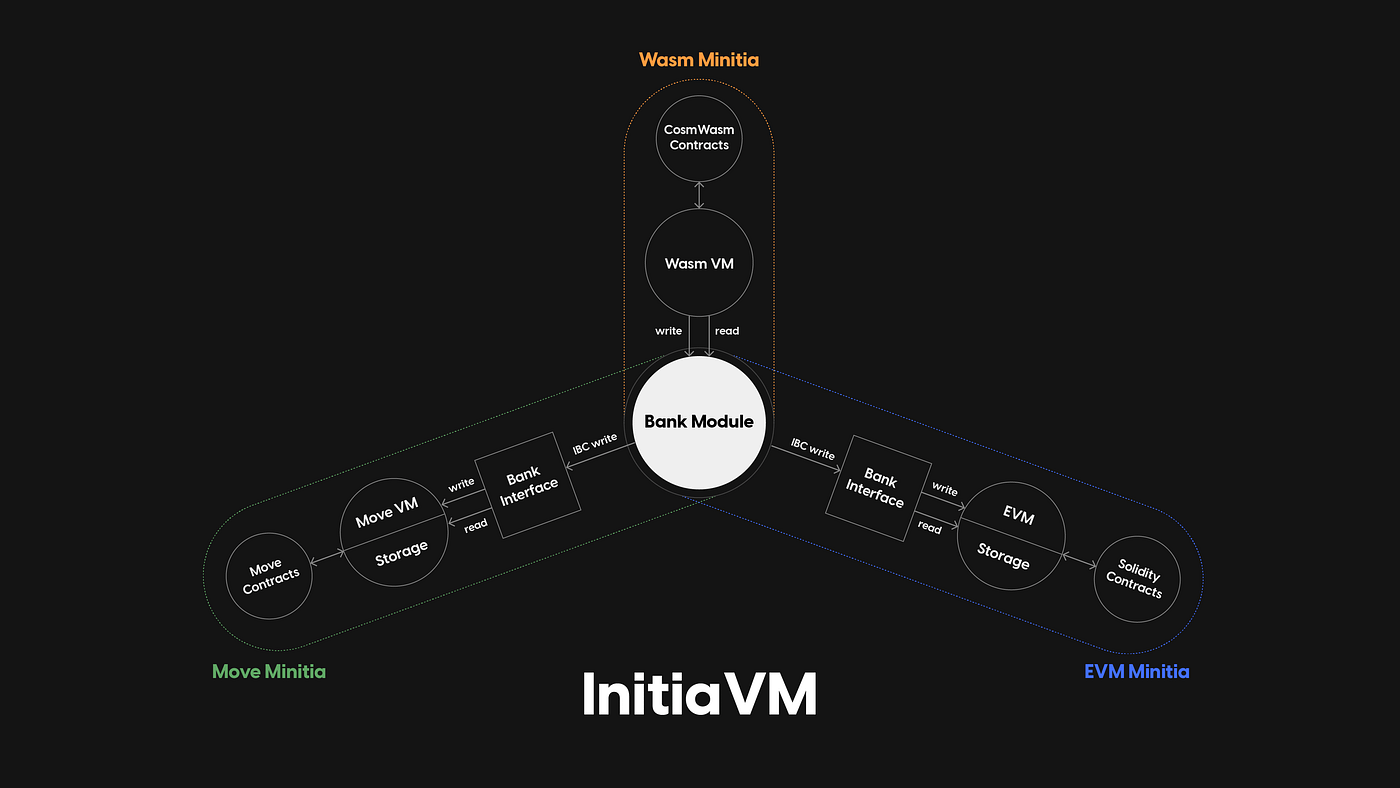
2- Developers Can Move In with Their Bags, Focusing Only on Users and Applications
Initia co-founder Zon mentioned that they are influenced by Apple's design philosophy. He compared Rollups on Ethereum to Android, pointing out that this architecture provides infrastructure, but users face many choices when selecting service providers, bridges, or oracles. In contrast, Initia takes a more definitive stance in its design, clarifying the evolution direction of the system.
In Initia's Layer 1 and Layer 2 framework, many components are embedded within the system. For example, bridging only uses IBC and Layer0, while DA relies on Celestia, among others. They believe that all applications should develop in a direction consistent with Layer1, thereby bringing value to users and the ecosystem.
Each Minitia is a fully equipped L2 environment, allowing applications with different needs to move in and become plug-and-play application chains without having to reinvent the wheel from 0 to 1.
Specifically, in addition to high performance and interoperability, Initia's built-in key components include but are not limited to: unified wallet services, username services, blockchain explorers, oracles, economic incentive programs, one-click receipt of native USDC, and support for various SDKs.

Through these plug-and-play facilities, each Minitia provides the optimal environment for specific applications. This design not only lowers the entry barrier for developers but also accelerates application deployment and market promotion, allowing developers to focus on innovation rather than infrastructure building.
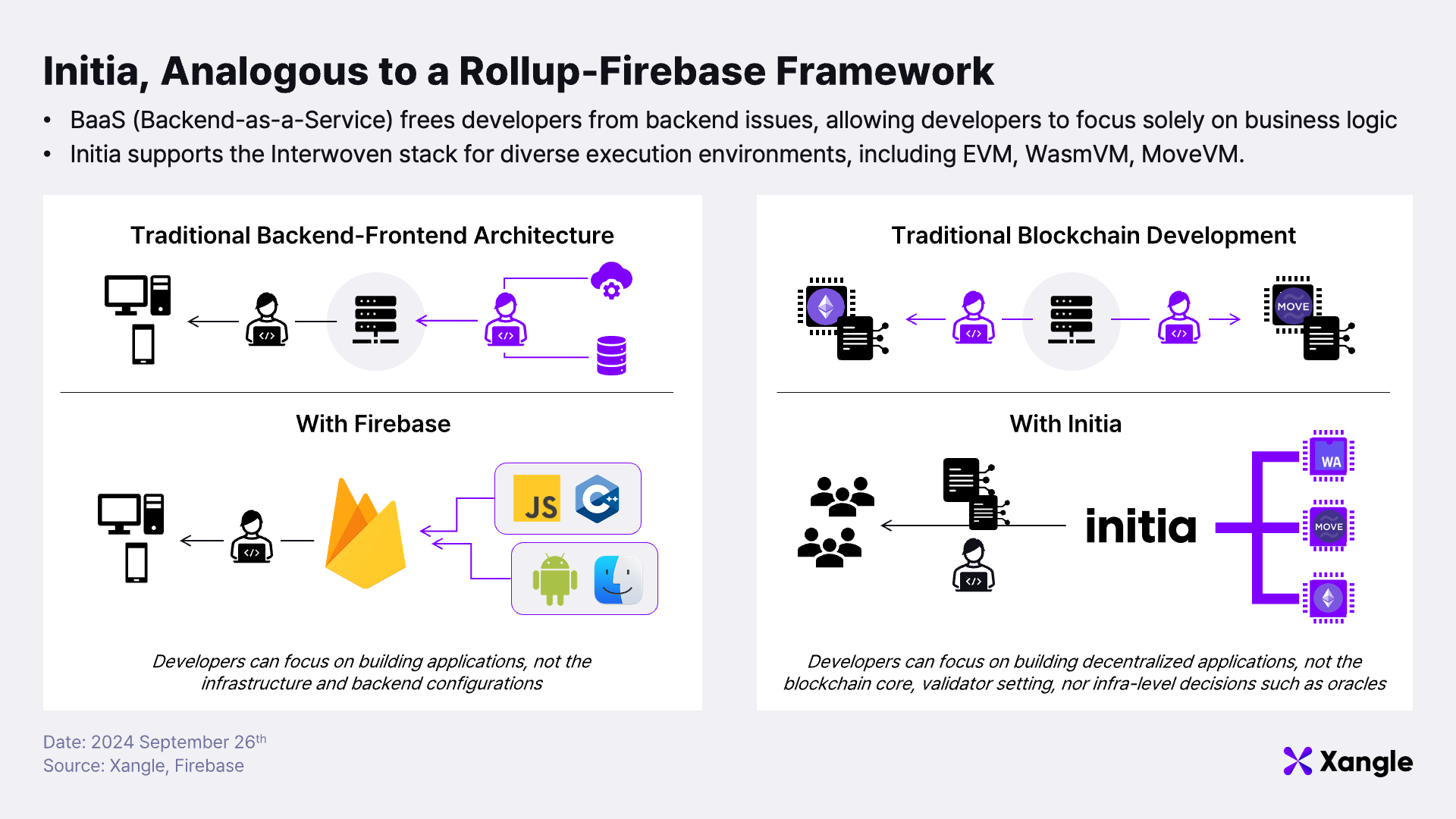
By Xangle
Ecosystem Development: Users/Developers/Initia Intertwined as a Community of Interests
VIP Program: Users/Developers/Initia Moving in One Direction
We have mentioned the "VIP" program multiple times; why is it so important for Initia?
Initia will allocate a portion of $INIT specifically for the "VIP" program. These $INIT will be distributed as specific rewards to the operators and users of Minitia based on the operational status of each Minitia. The specifics of how rewards are distributed and their amounts will be decided through voting.
User rewards are tied to their activities on specific platforms. For example, if users remain active on a particular application, they can unlock more tokens. This incentivizes users to continue participating, thereby driving the growth of the ecosystem.
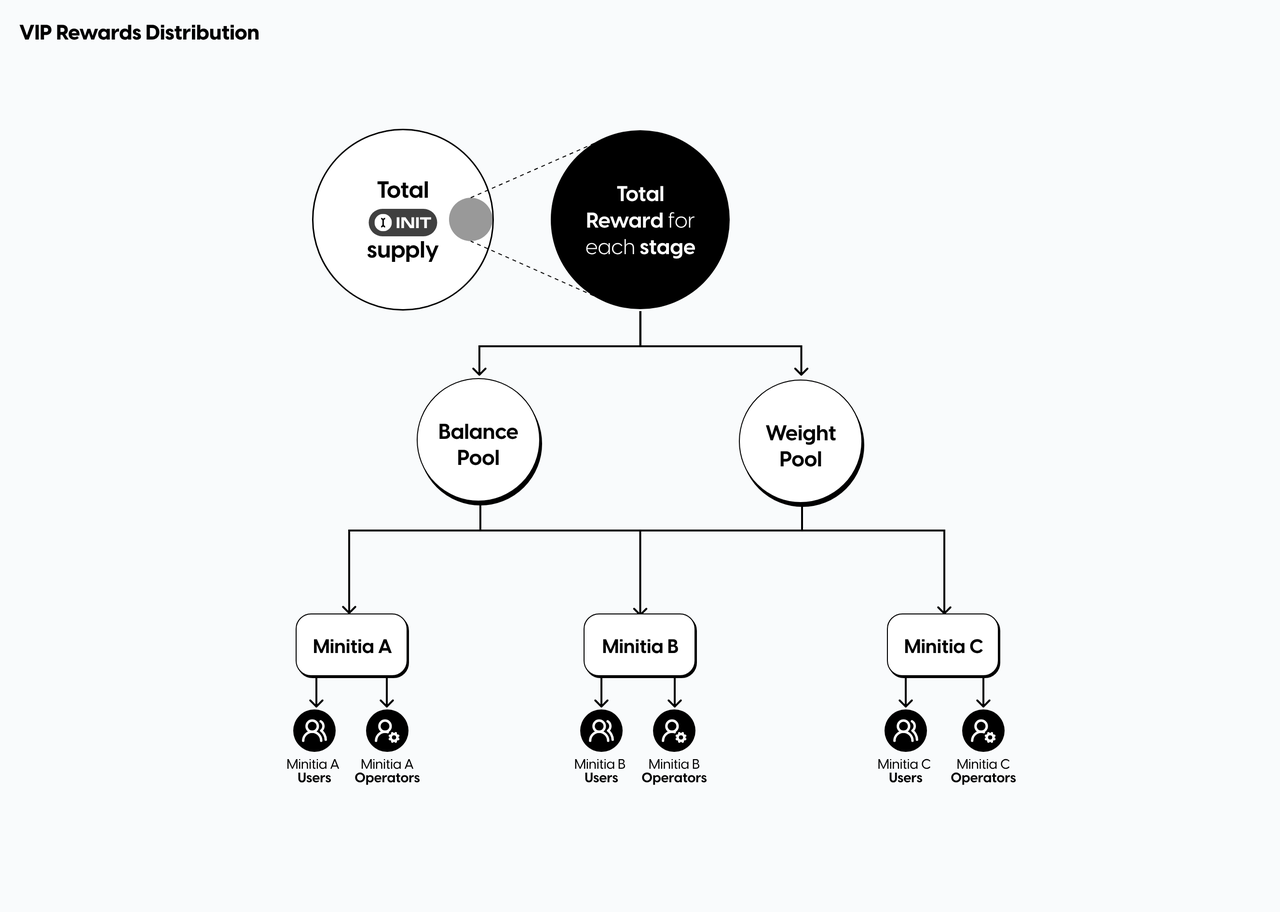
The two co-founders previously mentioned that the VIP program will eliminate intermediaries in traditional grant programs, ensuring that all rewards go directly to the end users rather than being consumed by teams or treasury. Developers will also benefit from this, as they attract users and create economic value for the ecosystem.
The goal of the VIP program is to coordinate the interests of all participants within the ecosystem, including Minitia teams, Minitia users, and the broader Initia ecosystem.
Seeking Innovative Teams to Support Native Application Development
Building an ecosystem can be easy or difficult.
The easy part is that you can directly attract some mature projects to fork onto your chain through incentives; the difficult part is that these projects, while seemingly enriching your ecosystem, often lack loyalty and sustainability.
Initia does not wish to attract projects from other ecosystems and attempt to "normalize" them; instead, they encourage unique and innovative teams to build their own native applications for Initia. At the same time, Initia will provide these teams with marketing, incentives, and development support.
From the official website, there are currently 12 disclosed ecosystem projects (Minitias) covering AI, DeFi, GameFi, and NFTs, as follows:

Many of these projects also involve institutions such as Binance Labs, Hashed, Polychain, and HackVC, reflecting market recognition of Initia's narrative.
Advocating Value Data: Mainnet and TGE Launching in Q4
Recently, Initia completed a 12-week testnet activity where users needed to complete multiple activities and remain active to receive the final Jennie NFT reward (Jennie is the pet of the Initia team and a major source of various memes). Additionally, users who deeply participate in the VIP program and interact with MinitSwap, Minitias, etc., can also receive specific Stickers.
The following are the activity data shared by the official team. Overall, this event attracted over 3 million active wallet addresses, with more than 100 million transactions.

From my personal experience participating, Initia's testnet activity required long-term activity and certification requirements (such as GitHub scores, Google scores, etc.), which to some extent avoided simple bot participation.
Moreover, it is worth noting that Initia has also revealed in this funding round that it will launch the mainnet and TGE in the next two months.
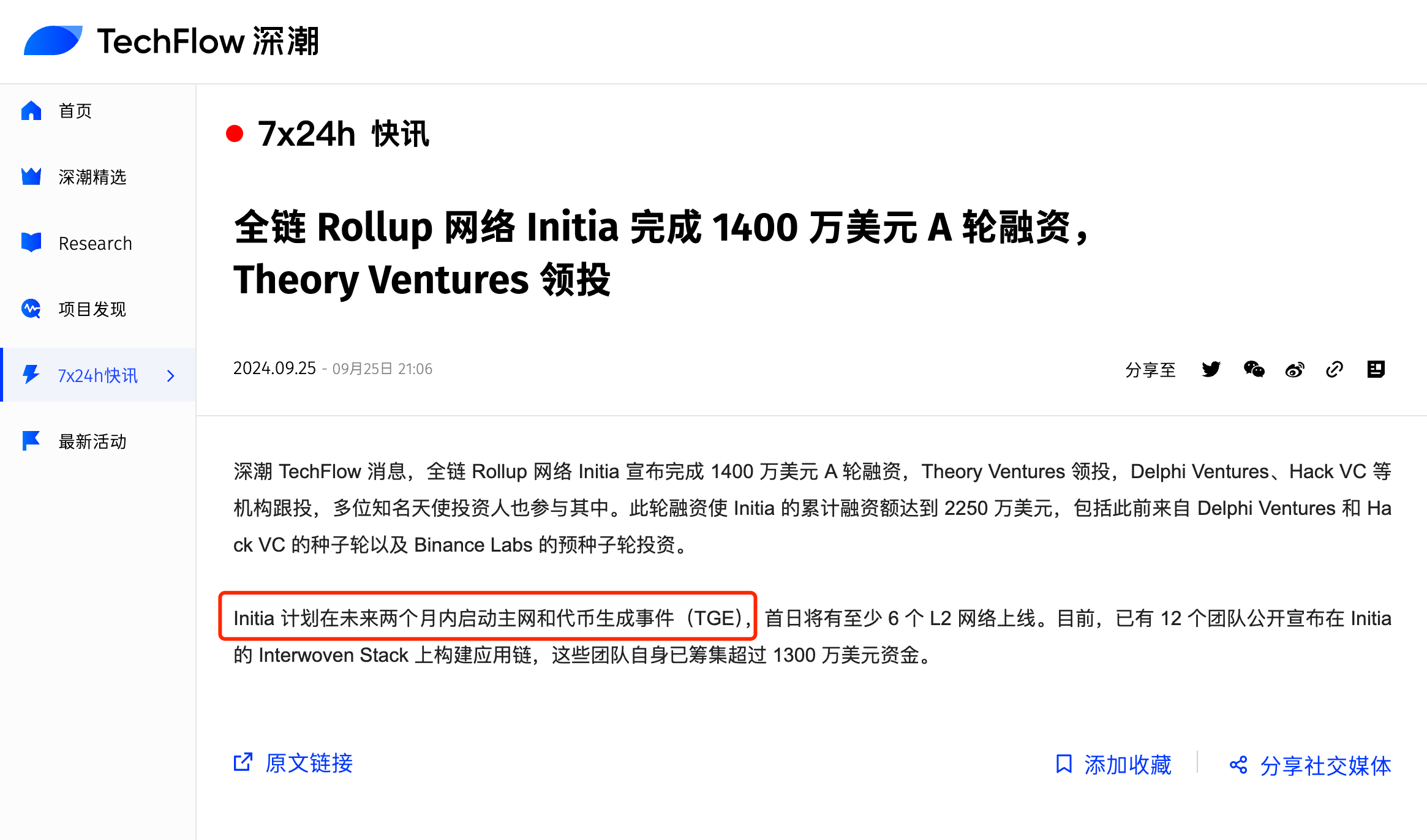
Many people are paying attention to Initia, possibly because of Binance Labs' early involvement. Personally, I believe that having a strong VC background is just one aspect; the influence of "well-known VCs" is gradually diminishing. From a previous survey, it can be seen that users are increasingly skeptical of the "well-known VC" narrative.
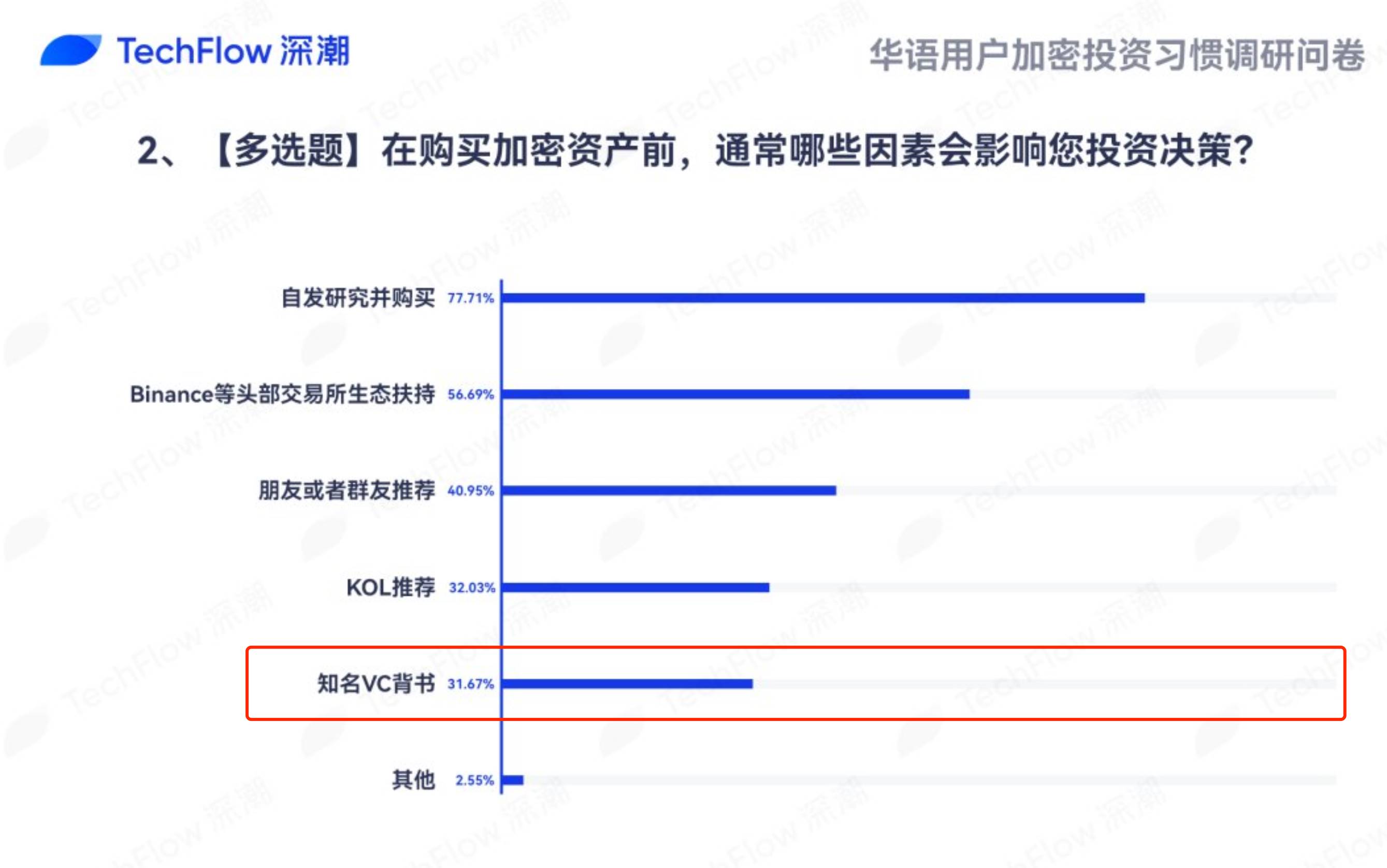
If a project lacks a solid community foundation and does not engage with users and ecosystem projects, it is destined to become an empty shell.
I initially focused on Initia simply because I saw cultural tags like Yu-Gi-Oh, One Piece, and Neon Genesis Evangelion being prominently used in the team's social media.

It wasn't until I discovered how they infused culture into the team, community, activities, and ecosystem projects that I truly understood the importance of "having fun" and "making the ecosystem interesting" for building a community.
We are all Jennie's fans.
免责声明:本文章仅代表作者个人观点,不代表本平台的立场和观点。本文章仅供信息分享,不构成对任何人的任何投资建议。用户与作者之间的任何争议,与本平台无关。如网页中刊载的文章或图片涉及侵权,请提供相关的权利证明和身份证明发送邮件到support@aicoin.com,本平台相关工作人员将会进行核查。



